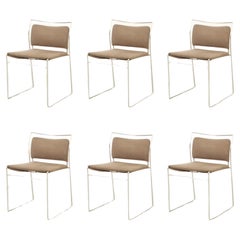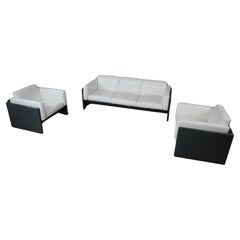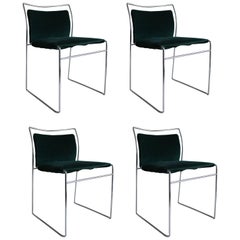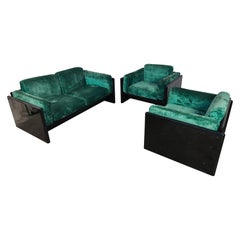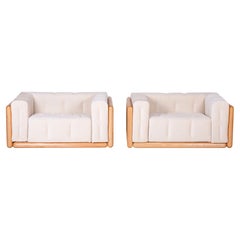Simon International Seating
4
to
1
4
4
4
4
2
1
4
2
2
1
1
Height
to
Width
to
Depth
to
2
1
1
2
2
2
1
1
4
4
7
1,349
1,146
1,145
1,068
Creator: Simon International
Set of Six Tulu Chairs by Kazuhide Takahama for Simon International, 1967
By Kazuhide Takahama, Simon International
Located in Barcelona, ES
Set of six Tulu chairs designed in 1967 by Japanese architect and designer Kazuhide Takahama for Simon International, Italy. They are the Spanish edition for MYC, signed. Steel rod s...
Category
1960s Italian Mid-Century Modern Vintage Simon International Seating
Materials
Steel
Arnolfo sofa set by Mauro Marzocchi for Simon International, 1971
By Simon International, Dino Gavina
Located in Langemark-Poelkapelle, BE
"Arnolfo" sofa set by Mauro Marzocchi for Simon International, 1971 Italy.
Grey lacquered high gloss wooden frame and original upholstery in stunning white leather!
The set features...
Category
Late 20th Century Italian Minimalist Simon International Seating
Materials
Leather, Wood
Kazuhide Takahama 'Tulu' Chair in Red Corduroy for Simon International 1966
By Simon International, Kazuhide Takahama
Located in Tilburg, NL
Kazuhide Takahama 'Tulu' Chair in Red Corduroy for Simon International, Italy, 1968.
Beautiful slender and sleek (side) chair by renowned designer Kazuhide Takahama (1930-2010). He ...
Category
Mid-20th Century Italian Mid-Century Modern Simon International Seating
Materials
Metal
Black Lacquered Dining Chairs Kazuki by Kazuhide Takahama for Simon, Italy, 1970
By Simon International, Kazuhide Takahama
Located in Renens, CH
Black lacquered wood dining chairs Kazuki by Kazuhide Takahama for Simon Gavina, Italy.
The Japanese architect and designer Takahama emigrated to Italy end of the 1950's to start working with Diego Gavina with whom he started a long lasting collaboration.
He designed for the Simon branch of Gavina's company a series of lacquered furniture such as the Antella console, the Bramante cupboard inspired by ancient Japanese lacquered wood craftsmanship.
The Kazuki chair...
Category
1970s Italian Modern Vintage Simon International Seating
Materials
Wood
Related Items
Mid-Century set of "Tulu" Chairs by Kazhuide Takahama for Simon Gavina, Italy '68
By Kazuhide Takahama, Simon Gavina Editions
Located in Sacile, PN
Set of four "Tulu" chairs by Kazuhide Takahama for Gavina Studio Simon, 1968.
This set is for the first series because is without the crossbar on the front of the seat.
New foa...
Category
1960s Italian Mid-Century Modern Vintage Simon International Seating
Materials
Metal, Chrome
H 28.75 in W 17.72 in D 16.93 in
Mid-Century set of four Italian "Tulu" Chairs by K. Takahama for Gavina, 1969.
By Kazuhide Takahama, Simon Gavina Editions
Located in Sacile, PN
Set of four grey "Tulu" chairs by Kazuhide Takahama for Gavina Studio Simon, 1969.
This set is for a second series as shown in the crossbar on the front of the seat
New foam pa...
Category
1960s Italian Mid-Century Modern Vintage Simon International Seating
Materials
Metal
H 29.14 in W 17.72 in D 17.72 in
Kazuhide Takahama Mid-Century Modern Velvet Tulu Chairs to MYC Gavina Set of Six
By Gavina, Kazuhide Takahama
Located in Escalona, Toledo
Set of six "Tulu" model chairs, designed by Kazuhide Takahama for Simon Gavina. Edition manufactured by MYC Gavina, Spain.
Elegant, light and comfortable.
One of the first modern sta...
Category
Mid-20th Century Spanish Mid-Century Modern Simon International Seating
Materials
Steel, Chrome
H 28.75 in W 18.9 in D 20.87 in
Mario Bellini "Le Bambole" Living Room Set for B&B Italia, 1971, Set of 3
By Mario Bellini, B&B Italia
Located in Lonigo, Veneto
Mario Bellini "Le Bambole" living room set for B&B Italia, three-seater sofa and two armchairs, faux-fur, foam and metal, Italy, 1971, set of three.
The search for a new shape for u...
Category
1970s Italian Mid-Century Modern Vintage Simon International Seating
Materials
Metal
H 28.35 in W 94.49 in D 33.47 in
Set of Eight Dining Chairs Design Kazuhide Takahama for Simon Gavina, Italy 1968
By Kazuhide Takahama
Located in Napoli, IT
Set of eight dining chairs in steel and covered in fabric designed by Kazuhide Takahama for Simon Gavina, Italy, 1968.
Category
1960s Italian Mid-Century Modern Vintage Simon International Seating
Materials
Steel
H 26.38 in W 19.69 in D 19.3 in
Midcentury Jano Chairs by Kazuhide Takahama Cassina
By Kazuhide Takahama, Simon Gavina Editions
Located in BROOKLYN, NY
For your consideration are these wonderful Jano chairs designed by Kazuhide Takahama. Featuring original upholstery on chrome steel frame. These are original and produced by Simon Gavina and now Cassina. Fits perfectly in any midcentury or Postmodern home...
Category
Mid-20th Century Italian Mid-Century Modern Simon International Seating
Materials
Chrome
Mario Bellini "Le Bambole" Sofa for B&B Italia, Lapin Fur, 1971
By Mario Bellini, B&B Italia
Located in Lonigo, Veneto
Mario Bellini “Le Bambole” two-seater sofa for B&B Italia, lapin fur, Italy, 1971.
This timeless Postmodern design icon came into being between 1970 and 1972. The search for a new...
Category
1970s Italian Mid-Century Modern Vintage Simon International Seating
Materials
Iron
Mario Bellini "Le Bambole" Sofa for B&B Italia, Faux-Fur, 1971, Set of 2
By B&B Italia, Mario Bellini
Located in Lonigo, Veneto
Mario Bellini “Le Bambole” two-seater sofa for B&B Italia, Mongolian faux-fur, Italy, 1971, set of two.
This is a timeless Postmodern design icon. The starting point was a shopping ...
Category
1970s Italian Mid-Century Modern Vintage Simon International Seating
Materials
Iron
H 29.53 in W 63 in D 33.47 in
Set of 8 mod. Rennie by Kazuhide Takahama for Simon Gavina, 1970
By Kazuhide Takahama, Simon Gavina Editions
Located in Piacenza, Italy
Stunning set composed by 8 chairs designed by Kazuhide Takahama and produced for Simon Gavina.
Original lacquered wood structure with leather cover and seat.
Perfect vintage conditi...
Category
1970s Italian Mid-Century Modern Vintage Simon International Seating
Materials
Leather, Wood
Carlo Scarpa Iroko Wood and Green Velvet Cornaro Sofa for Studio Simon, 1974
By Carlo Scarpa, Studio Simon
Located in Vicenza, IT
Cornaro two-seater sofa, designed by Carlo Scarpa and manufactured by Studio Simon in 1974.
Made of Iroko wood, foam, and azure chenille velvet.
Excellent vintage condition.
Born in Venice on June 2nd, 1906, Carlo Scarpa began working very early. Only a year after he had first qualified as an architect in 1926, he began working for the Murano glassmakers Cappellin & Co. in a consultative capacity; from 1927, he began to experiment with the Murano glass, and this research not only gave him excellent results here but would also inform his progress for many years to come. Between 1935 and 1937, as he entered his thirties, Carlo Scarpa accepted his first important commission, the renovation of Venice’s Cà Foscari. He adapted the spaces of this stately University building which stands on the banks of the Grand Canal, creating rooms for the Dean’s offices and a new hall for academic ceremonies; Mario Sironi and Mario De Luigi were charged with doing the restoration work on the frescos. After 1945, Carlo Scarpa was constantly busy with new commissions, including various furnishings and designs for the renovation of Venice’s Hotel Bauer and designing a tall building in Padua and a residential area in Feltre, all worth mentioning. One of his key works, despite its relatively modest diminished proportions, was the first of many works which were to follow in the nineteen fifties: the [bookshop known as the] Padiglione del Libro, which stands in Venice’s Giardini di Castello and shows clearly Scarpa’s passion for the works of Frank Lloyd Wright. In the years which were to follow, after he had met the American architect, Scarpa repeated similar experiments on other occasions, as can be seen, in particular, in the sketches he drew up in 1953 for villa Zoppas in Conegliano, which show some of his most promising work. However, this work unfortunately never came to fruition. Carlo Scarpa later created three museum layouts to prove pivotal in how twentieth-century museums were set up from then on. Between 1955 and 1957, he completed extension work on Treviso’s Gipsoteca Canoviana [the museum that houses Canova’s sculptures] in Possagno, taking a similar experimental approach to the one he used for the Venezuelan Pavilion at [Venice’s] Giardini di Castello which he was building at the same time (1954-56). In Possagno Carlo Scarpa was to create one of his most incredible ever works, which inevitably bears comparison with two other museum layouts that he was working on over the same period, those of the Galleria Nazionale di Sicilia, housed in the Palazzo Abatellis in Palermo (1953-55) and at the Castelvecchio in Verona (1957- 1974), all of which were highly acclaimed, adding to his growing fame. Two other buildings, which are beautifully arranged in spatial terms, can be added to this long list of key works that were started and, in some cases, even completed during the nineteen fifties. After winning the Olivetti Award for architecture in 1956, Scarpa began work in Venice’s Piazza San Marco on an area destined to house products made by the Industrial manufacturers Ivrea. Over the same period (1959-1963), he also worked on renovating and restoring the gardens and ground floor of the Fondazione Querini Stampalia in Venice, which many consider one of his greatest works. While he worked on-site at the Fondazione Querini Stampalia, Carlo Scarpa also began building a villa in Udine for the Veritti family. To shed some light on how much his work evolved over the years, it may be useful to compare this work with that of his very last building, villa Ottolenghi Bardolino, which was near completion at the time of his sudden death in 1978. Upon completion of villa Veritti over the next ten years, without ever letting up on his work on renovation and layouts, Scarpa accepted some highly challenging commissions which were to make the most of his formal skills, working on the Carlo Felice Theatre in Genoa as well as another theatre in Vicenza.
Towards the end of this decade, in 1969, Rina Brion commissioned Carlo Scarpa to build the Brion Mausoleum in San Vito d’Altivole (Treviso), a piece he continued to work on right up until the moment of his death. Nevertheless, even though he was totally absorbed by work on this mausoleum, plenty of other episodes can offer some insight into the final years of his career. As work on the San Vito d’Altivole Mausoleum began to lessen in 1973, Carlo Scarpa started building the new headquarters for the Banca Popolare di Verona. He drew up plans that were surprisingly different from the work he carried out simultaneously on the villa Ottolenghi. However, the plans Carlo Scarpa drew up, at different times, for a monument in Brescia’s Piazza della Loggia commemorating victims of the terrorist attack on May 28th, 1974, make a sharp contrast to the work he carried out in Verona, almost as if there is a certain hesitation after so many mannered excesses. The same Pietas that informs his designs for the Piazza Della Loggia can also be seen in the presence of the water that flows through the Brion Mausoleum, almost as if to give a concrete manifestation of pity in this twentieth-century work of art. Carlo Scarpa has put together a highly sophisticated collection of structures occupying the mausoleum’s L-shaped space stretching across both sides of the old San Vito d’Altivole cemetery. A myriad of different forms and an equally large number of different pieces, all of which are separate and yet inextricably linked to form a chain that seems to offer no promise of continuity, arising out of these are those whose only justification for being there is to bear the warning “si vis vitam, para mortem,” [if you wish to experience life prepare for death] as if to tell a tale that suggests the circle of time, joining together the commemoration of the dead with a celebration of life. At the entrance of the Brion Mausoleum stand the “propylaea,” followed by a cloister that ends by a small chapel, with an arcosolium bearing the family sarcophagi, the central pavilion, held in place on broken cast iron supports, stands over a mirror-shaped stretch of water and occupies one end of the family’s burial space. The musical sound of the walkways, teamed with the luminosity of these harmoniously blended spaces, shows how, in keeping with his strong sense of vision, Carlo Scarpa could make the most of all his many skills to come up with this truly magnificent space. As well as an outstanding commitment to architectural work, with the many projects we have already seen punctuating his career, Carlo Scarpa also made many equally important forays into the world of applied arts. Between 1926 and 1931, he worked for the Murano glassmakers Cappellin, later taking what he had learned with him when he went to work for the glassmakers Venini from 1933 until the 1950s. The story of how he came to work on furniture design is different, however, and began with the furniture he designed to replace lost furnishings during his renovation of Cà Foscari. The later mass-produced furniture started differently, given that many pieces were originally one-off designs “made to measure.” Industrial manufacturing using these designs as prototypes came into being thanks to the continuity afforded him by Dino Gavina, who, as well as this, also invited Carlo Scarpa to become president of the company Gavina SpA, later to become SIMON, a company Gavina founded eight years on, in partnership with Maria Simoncini (whose own name accounts for the choice of company name). Carlo Scarpa and Gavina forged a strong bond in 1968 as they began to put various models of his into production for Simon, such as the “Doge” table, which also formed the basis for the “Sarpi” and “Florian” tables. In the early seventies, other tables that followed included “Valmarana,” “Quatour,” and “Orseolo.” While in 1974, they added a couch and armchair, “Cornaro,” to the collection and the “Toledo” bed...
Category
1970s Italian Mid-Century Modern Vintage Simon International Seating
Materials
Velvet, Foam, Chenille, Wood
H 25.6 in W 86.62 in D 34.26 in
Lacquered lounge chair by Kazuhide Takahama for Simon 70s
By Simon Gavina Editions, Kazuhide Takahama
Located in Padova, IT
In black lacquered wood, sage colored corduroy covering.
CONDITION: very good with small and inevitable signs of age and use, padding and cushion covering completely renewed.
Kazuhid...
Category
1970s Italian Mid-Century Modern Vintage Simon International Seating
Materials
Velvet, Wood
Set of Six Tulu Chairs by Kazuhide Takahama for Simon Gavina
By Studio Simon, Kazuhide Takahama
Located in Dronten, NL
The Tulu chair was designed by the Japanese designer Kazuhide Takahama for Simon International in 1966.
The Tulu is one of the very first models that paved the way for the use of chrome-plated steel rod. The steel rod makes it possible to produce softly curved, extremely rounded structures. The back and seat upholstery is attached with zippers and completely removable.
The dark blue Alcantara fabric is great, it is the Italian version of Ultrasuede. It feels like natural suede, but it is resistant to stains and discoloration; it can be washed in a washing machine.
These elegant stackable chairs are in very good all original condition.
They are an early production of Simon International and marked with a silver foil label inside the seat.
This set was bought by the original owners in 1970 together with a Sarpi table...
Category
1960s Italian Mid-Century Modern Vintage Simon International Seating
Materials
Steel, Chrome
Previously Available Items
Lacquered Sofa and Armchairs by Kazuhide Takahama for Simon International 1970s
By Simon International, Kazuhide Takahama
Located in Padova, IT
Outstanding living room set composed of a 2 seater sofa and 2 armchairs designed by Kazuhide Takahama and produced by Simon Internationalin 1970s.
Frame made by black lacquered wood...
Category
1970s Italian Mid-Century Modern Vintage Simon International Seating
Materials
Velvet, Wood
H 27.56 in W 31.5 in D 63 in
Set of 2 Cornaro 140 Armchair by Carlo Scarpa
By Simon International, Carlo Scarpa
Located in Brooklyn, NY
Cornaro 140 armchair designed by Carlo Scarpa. Two pieces available.
Ash wood structure, recently upholstered with linen velvet. Polyurethane padding. The one-unit side and back cushion is fastened to the frame corners.
At the beginning of the ’70s Cornaro was born as an example of the Ultrarazionale style: a sofa with a solid hardwood structure, which makes this piece very powerful.
Bibliography
Accademia delle Belle Arti di Brera, “Dino Gavina Ultrarazionale Ultramobile”, Editrice Compositori, Milano 1998, pp. 132, 133
Fondazione Scientifica Querini Stampalia, “Dino Gavina, collezioni emblematiche del moderno dal 1950 al 1992”, Jaca Book, Milano 1992, p. 70
Virgilio Vercelloni, “L’ avventura del design: Gavina”, Jaca Book, Milano 1987, p. 93, images 61,62,63,64
“Carlo Scarpa Sandro Bagnoli Il design per Dino Gavina” edited by Sandro Bagnoli, Alba Di Lieto...
Category
1970s Italian Modern Vintage Simon International Seating
Materials
Wood, Velvet
Simon International seating for sale on 1stDibs.
Simon International seating are available for sale on 1stDibs. These distinctive items are frequently made of metal and are designed with extraordinary care. There are many options to choose from in our collection of Simon International seating, although black editions of this piece are particularly popular. Many of the original seating by Simon International were created in the modern style in italy during the 20th century. Prices for Simon International seating can differ depending upon size, time period and other attributes — on 1stDibs, these items begin at $950 and can go as high as $7,634, while a piece like these, on average, fetch $3,044.
